Exchange Currency
Yemeni rial
The rial or riyal is the currency of Yemen. It is technically divided into 100 fils, although coins denominated in fils have not been issued since Yemeni unification.
The Federation of Arab Emirates of the South was formed on February 11, 1959, and included 17 South Arabian countries. On April 4, 1962, the Aden colony joined the Federation and it was renamed the Federation of South Arabia. The Federation gained its independence as the Peoples Republic of South Yemen on November 30, 1967.
The Qasimi state (Sana) was founded in September 1597. It was occupied by the Ottoman Empire in 1872 and annexed in 1876. It gained its independence on October 30, 1918, and became the Mutawakkilite Kingdom of Yemen on September 2, 1926. It was renamed the Yemen Arab Republic on September 27, 1962. The two states were unified on May 22, 1990 as the Republic of Yemen.
Athenian silver tetradrachms reached present-day Yemen during the fourth century BC, and local coins, imitating the Athenian owls, were minted in Yemen soon after. Roman coins were imported during the first century BC, and Yemeni coins were issued by the Sabaeans, Minaeans and Himyarites and modified to imitate Roman coins using a bust similar to that of Augustus (31 BC AD 14).
The Yemen became an Islamic province in 628, and the first Islamic coins were issued under the Abbasid caliphs in 772. Silver coins were issued in Sana'a in 788 and gold coins were struck in 835. During the second half of the eleventh century, the Sulayhi rulers (1047-1138) began to issue coins in the Egyptian Fatimid style. In 1174 Turanshah, the brother of Saladin, conquered Yemen and began issuing Ayyubid-style silver coins.
After the army of Suleyman the Magnificent completed their conquest of Yemen in 1538, the Ottomans issued gold, silver and copper coins in the Ottoman style. Ottoman coins from Egypt and Syria, as well as Maria Theresa Thalers and gold ducats were imported into Yemen.
Indian Rupees (INR) were used in Aden, while both Indian Rupees and Maria Theresa Thalers were used in the protectorates in South Arabia. Some smaller coins were issued by local states. British Indian currency was the official legal tender in Aden from 1839 to 1951, though British sterling, Iranian coins and Maria Theresa Thalers were used as well.
On October 1, 1951, the East African Shilling (XEAS) replaced the Indian Rupee as the primary medium of exchange because India was no longer under British rule. The South Yemen Dinar (YDD) was introduced on April 1, 1965 by the South Yemeni government equal to 20 East African Shillings and at par with the British Pound Sterling. Banknotes were issued by the South Arabian Currency Authority from April 1, 1965 until August 25, 1972 and by the Bank of Yemen from then until 1990. The Bank of Yemen continued to issue South Arabian Currency Authority banknotes until 1984 when the notes were finally issued under the name of the Bank of Yemen. The Dinar was divisible into 1000 Fils. The Dinar ceased to be used after Yemen was united, but Dinar banknotes retained legal tender status until June 11, 1996.
After Yemen gained its independence from the Ottoman Turks, the Yemeni Imadi Riyal (YEI), equivalent to the Maria Theresa Thaler (XMT T), was issued until the 1830s when minting stopped until 1900. During the 1800s, Maria Theresa Thalers, British sovereigns, Indian Rupees and Ottoman coins from Egypt circulated in Yemen. The Ottomans ruled Turkey between 1872 and 1918, but Imam Yahya smuggled in British minting machinery to issue coins from 1900 on. The primary subsidiary coinage was the Choice, of which there were 120 to the Riyal. Ottoman Empire Piastres (XOPT) were also used while Yemen was part of the Ottoman Empire.
When the Yemen Arab Republic gained its independence, Maria Theresa Thalers and other foreign coins were used. The Yemen Arab Republic introduced the Rial (YER), issued by the Yemen Currency Board, its medium of exchange on May 8, 1964. The Rial was fixed at the rate of 3 YER = 1 Pound Sterling. The Rial was divisible into 40 Buqshas. The Yemen Currency Board issued banknotes between 1964 and 1973, and the Central Bank of Yemen, established on July 27, 1971, began issuing banknotes in 1973.
When Yemen was united in 1990, the Rial became the medium of exchange in the Republic of Yemen with 26 Rials equal to 1 Dinar. The Rial was divisible into 40 Buqshas until April 1, 1995 when it became divisible into 100 Fils. The Central Bank of Yemen is the sole note-issuing authority in Yemen.
However, the fils denominations have all disappeared from circulation. In 1993, new coins were introduced by the Central Bank of Yemen in denominations of 1 and 5 rials. These were followed by 10 rials coins in 1995 and 20 rials in 2004.
In 1996, 200 rials notes were introduced, followed by 500 rials in 1997 and 1000 rials in 1998. The 20 rials notes were replaced by coins in 2004. In addition, a 250 rial banknote was issued on November 14, 2009.
Summary info
Summary information about Yemeni rial- ISO 4217 Code:
- YER
- Currency sign:
- Country:
- Yemen
- Subunit:
- fils
- Coins:
- 1 rial, 5 rials, 10 rials, 20 rials
- Banknotes:
- 50 rials, 100 rials, 200 rials, 250 rials, 500 rials, 1000 rials
- Central bank:
- Central Bank of Yemen
History
By 1517 Yemen had fallen to the Ottoman Turks. In 1636 the Ottomans were expelled by the Zaydis of San'a, who took Aden but failed to hold it past 1735. Egypts attempts to extend its influence to Yemen let to British occupation of Aden on January 16, 1839. Aden, and thus Yemen, increased in importance with the opening of the Suez Canal. The Indian Empire established 18 protectorate treaties between 1888 and 1902 with different tribes in South Arabia. From then until February 11, 1959, the Aden colony and Aden protectorate existed (the two were separate legal entities), either subordinated to Bombay or a separate province of British India until 1937 when Aden fell under control of the Colonial Office.The Federation of Arab Emirates of the South was formed on February 11, 1959, and included 17 South Arabian countries. On April 4, 1962, the Aden colony joined the Federation and it was renamed the Federation of South Arabia. The Federation gained its independence as the Peoples Republic of South Yemen on November 30, 1967.
The Qasimi state (Sana) was founded in September 1597. It was occupied by the Ottoman Empire in 1872 and annexed in 1876. It gained its independence on October 30, 1918, and became the Mutawakkilite Kingdom of Yemen on September 2, 1926. It was renamed the Yemen Arab Republic on September 27, 1962. The two states were unified on May 22, 1990 as the Republic of Yemen.
Athenian silver tetradrachms reached present-day Yemen during the fourth century BC, and local coins, imitating the Athenian owls, were minted in Yemen soon after. Roman coins were imported during the first century BC, and Yemeni coins were issued by the Sabaeans, Minaeans and Himyarites and modified to imitate Roman coins using a bust similar to that of Augustus (31 BC AD 14).
The Yemen became an Islamic province in 628, and the first Islamic coins were issued under the Abbasid caliphs in 772. Silver coins were issued in Sana'a in 788 and gold coins were struck in 835. During the second half of the eleventh century, the Sulayhi rulers (1047-1138) began to issue coins in the Egyptian Fatimid style. In 1174 Turanshah, the brother of Saladin, conquered Yemen and began issuing Ayyubid-style silver coins.
After the army of Suleyman the Magnificent completed their conquest of Yemen in 1538, the Ottomans issued gold, silver and copper coins in the Ottoman style. Ottoman coins from Egypt and Syria, as well as Maria Theresa Thalers and gold ducats were imported into Yemen.
Indian Rupees (INR) were used in Aden, while both Indian Rupees and Maria Theresa Thalers were used in the protectorates in South Arabia. Some smaller coins were issued by local states. British Indian currency was the official legal tender in Aden from 1839 to 1951, though British sterling, Iranian coins and Maria Theresa Thalers were used as well.
On October 1, 1951, the East African Shilling (XEAS) replaced the Indian Rupee as the primary medium of exchange because India was no longer under British rule. The South Yemen Dinar (YDD) was introduced on April 1, 1965 by the South Yemeni government equal to 20 East African Shillings and at par with the British Pound Sterling. Banknotes were issued by the South Arabian Currency Authority from April 1, 1965 until August 25, 1972 and by the Bank of Yemen from then until 1990. The Bank of Yemen continued to issue South Arabian Currency Authority banknotes until 1984 when the notes were finally issued under the name of the Bank of Yemen. The Dinar was divisible into 1000 Fils. The Dinar ceased to be used after Yemen was united, but Dinar banknotes retained legal tender status until June 11, 1996.
After Yemen gained its independence from the Ottoman Turks, the Yemeni Imadi Riyal (YEI), equivalent to the Maria Theresa Thaler (XMT T), was issued until the 1830s when minting stopped until 1900. During the 1800s, Maria Theresa Thalers, British sovereigns, Indian Rupees and Ottoman coins from Egypt circulated in Yemen. The Ottomans ruled Turkey between 1872 and 1918, but Imam Yahya smuggled in British minting machinery to issue coins from 1900 on. The primary subsidiary coinage was the Choice, of which there were 120 to the Riyal. Ottoman Empire Piastres (XOPT) were also used while Yemen was part of the Ottoman Empire.
When the Yemen Arab Republic gained its independence, Maria Theresa Thalers and other foreign coins were used. The Yemen Arab Republic introduced the Rial (YER), issued by the Yemen Currency Board, its medium of exchange on May 8, 1964. The Rial was fixed at the rate of 3 YER = 1 Pound Sterling. The Rial was divisible into 40 Buqshas. The Yemen Currency Board issued banknotes between 1964 and 1973, and the Central Bank of Yemen, established on July 27, 1971, began issuing banknotes in 1973.
When Yemen was united in 1990, the Rial became the medium of exchange in the Republic of Yemen with 26 Rials equal to 1 Dinar. The Rial was divisible into 40 Buqshas until April 1, 1995 when it became divisible into 100 Fils. The Central Bank of Yemen is the sole note-issuing authority in Yemen.
Coins
When Yemen unified, coins had been issued in North Yemen in denominations of 1, 5, 10, 25 and 50 fils and 1 rial.However, the fils denominations have all disappeared from circulation. In 1993, new coins were introduced by the Central Bank of Yemen in denominations of 1 and 5 rials. These were followed by 10 rials coins in 1995 and 20 rials in 2004.
Banknotes
At the time of unification, Central Bank of Yemen notes in circulation were 1, 5, 10, 20, 50 and 100 rials. In 1993, the 1 and 5 rials notes were replaced by coins, with the same happening to the 10 rials notes in 1995.In 1996, 200 rials notes were introduced, followed by 500 rials in 1997 and 1000 rials in 1998. The 20 rials notes were replaced by coins in 2004. In addition, a 250 rial banknote was issued on November 14, 2009.
YER banknotes pictures gallery
| 50 Yemeni rials | |
|---|---|
| Banknote of 50 Yemeni rials has dimensions 150×75 mm and main colors are tea green, shadow, dark tan, battleship grey, pale gold, desert sand, pale silver, timberwolf and grullo. The banknote of 50 Yemeni rials was issued in 1993. | |
 Obverse side of the 50 Yemeni rials is showing Bronze statue of Ma'ad Karib "Bronze man" found in Al Bayda (ancient Nashqa), now in Louvre Museum in Paris, France. |
 Reverse side of the 50 Yemeni rials is showing the Bab al Yemen in old Sana'a. |
| 100 Yemeni rials | |
|---|---|
| Banknote of 100 Yemeni rials has dimensions 150×75 mm and main colors are rose quartz, bazaar, lavender gray, old lavender, pale thistle, languid lavender and platinum. The banknote of 100 Yemeni rials was issued in 1993. | |
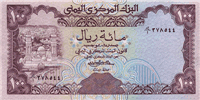 Obverse side of the 100 Yemeni rials is showing yemeni inscriptions of the Mosque and the city from a height. |
 Reverse side of the 100 Yemeni rials is showing a view of the city from a bird's eye view. |
| 200 Yemeni rials | |
|---|---|
| Banknote of 200 Yemeni rials has dimensions 155×75 mm and main colors are aurometalsaurus, pastel gray, battleship grey, taupe gray, tea green, light gray, gainsboro, pearl and silver. The banknote of 200 Yemeni rials was issued in 1996. | |
 Obverse side of the 200 Yemeni rials is showing the Alabaster stele sculpture of a warrior. |
 Reverse side of the 200 Yemeni rials is showing a view of the city of Al Mukalla as seen from the Indian Ocean. |
| 250 Yemeni rials | |
|---|---|
| Banknote of 250 Yemeni rials has dimensions 159×76 mm and main colors are khaki, timberwolf, raw , desert sand, tan, wenge, tumbleweed and ceil. The banknote of 250 Yemeni rials was issued in 2009. | |
 Obverse side of the 250 Yemeni rials is showing the Al-Saleh Mosque in Sana'a. |
 Reverse side of the 250 Yemeni rials is showing a view of the city of Al Mukalla and the estuary, Hadramaut. |
| 500 Yemeni rials | |
|---|---|
| Banknote of 500 Yemeni rials has dimensions 155×80 mm and main colors are pale aqua, light blue, platinum, lavender mist, pearl, light gray, lavender gray and gainsboro. The banknote of 500 Yemeni rials was issued in 2007. | |
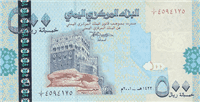 Obverse side of the 500 Yemeni rials is showing the Rock Palace at Wadi (Valley) Dahr. |
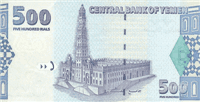 Reverse side of the 500 Yemeni rials is showing the Al-Muhtar Mosque in Tarim (Hadramaut). |
| 1000 Yemeni rials | |
|---|---|
| Banknote of 1000 Yemeni rials has dimensions 156×83 mm and main colors are almond, sand, wenge, silver, pearl, desert sand, pale silver and ash grey. The banknote of 1 000 Yemeni rials was issued in 2006. | |
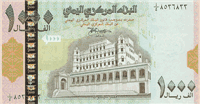 Obverse side of the 1000 Yemeni rials is showing the Seiyun Palace, formerly Al Kathiri Sultan's Palace at Seiyun (Seiyun) in Hadramawt. |
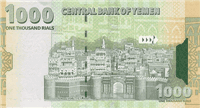 Reverse side of the 1000 Yemeni rials is showing the Bab Al-Yaman Gate and the city of Sana'a. |
Useful links
- About Central Bank of Yemen:
- Central Bank of Yemen
- List of currencies:
- Currencies
- Security and design features of YER banknotes:
- YER banknotes
- YER currency on Wikipedia:
- Yemeni rial
- Official Website of Central Bank of Yemen:
- www.centralbank.gov.ye
- Commemorative coins:
- Commemorative Coins